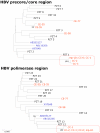Hospital cluster of HBV infection: molecular evidence of patient-to-patient transmission through lancing device
- PMID: 22412991
- PMCID: PMC3295785
- DOI: 10.1371/journal.pone.0033122
Hospital cluster of HBV infection: molecular evidence of patient-to-patient transmission through lancing device
Abstract
Introduction: In western countries the transmission of hepatitis B virus (HBV) transmission through multi-patients lancing devices has been inferred since early '90s, however no study has ever provided biological evidence which directly link these device with HBV cross-infection. Here we present results of an outbreak investigation which could associate, by molecular techniques, the use of lancing device on multiple patients with HBV transmission in an Italian oncohematology unit.
Methods: The outbreak investigation was designed as a retrospective cohort study to identify all potential cases. All cases identified were eventually confirmed through molecular epidemiology techniques. Audit of personnel including extensive review of infection control measures and reviewing personnel's tests for HBV was done identify transmission route.
Results: Between 4 May 2006 and 21 February 2007, six incident cases of HBV infection were reported among 162 patients admitted in the oncohematology. The subsequent molecular instigation proved that 3 out 6 incident cases and one prevalent cases (already infected with HBV at the admission) represented a monophyletic cluster of infection. The eventual environmental investigation found that an identical HBV viral strain was present on a multi-patients lancing device in use in the unit and the inferential analysis showed a statistically significant association between undergoing lancing procedures and the infection.
Discussion: This investigation provide molecular evidence to link a HBV infection cluster to multi-patients lancing device and highlights that patients undergoing capillary blood sampling by non-disposable lancing device may face an unacceptable increased risk of HBV infection. Therefore we believe that multi-patients lancing devices should be banned from healthcare settings and replace with disposable safety lancets that permanently retract to prevent the use of the same device on multiple patients. The use of non-disposable lancing devices should be restricted to individual use at patients' home.
Conflict of interest statement
Figures



References
-
- Thompson ND, Perz JF, Moorman AC, Holmberg SD. Nonhospital health care-associated hepatitis B and C virus transmission: United States, 1998–2008. Ann Intern Med. 2009;150:33–39. - PubMed
-
- Duffell EF, Milne LM, Seng C, Young Y, Xavier S, et al. Five hepatitis B outbreaks in care homes in the UK associated with deficiencies in infection control practice in blood glucose monitoring. Epidemiol Infect. 2011;139:327–335. - PubMed
Publication types
MeSH terms
LinkOut - more resources
Full Text Sources
Medical

